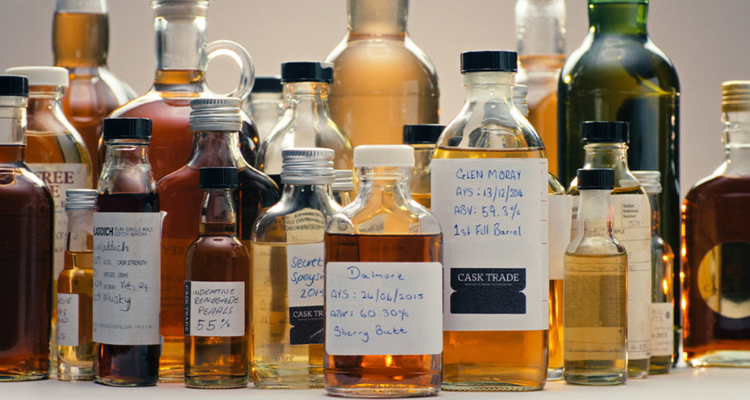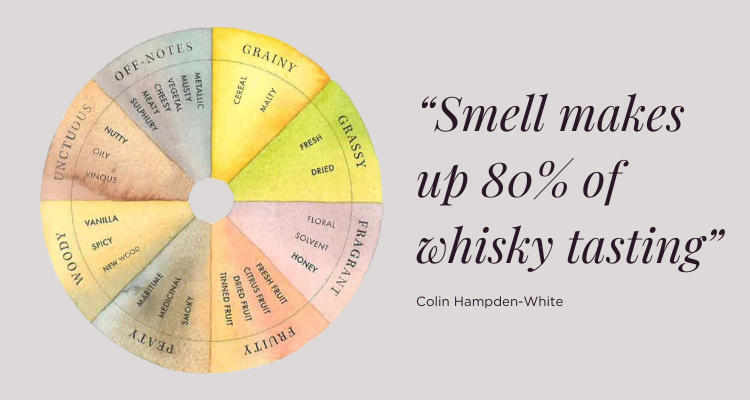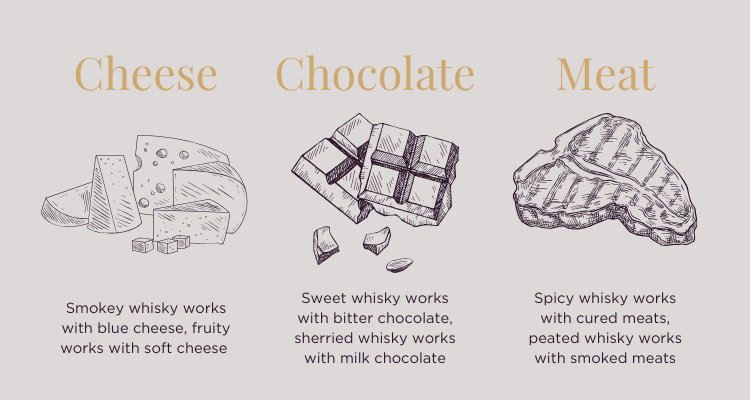A Guide To Tasting Scottish Whisky
Discover how to taste whisky like a pro with our comprehensive guide. Learn about whisky tasting notes like aroma, flavour, and finish.
Cask Trade
Table of contents
- A Guide To Tasting Scottish Whisky
- 5 Tips On How To Taste Whisky
- Typical Whisky Pairings
- Whisky Terminology
- Conclusion
Much like wine, whisky is one of the few drinks in the world to benefit from a full tasting experience rather than simply being a drink. It has so many different characters, aromas and flavours due to the aging process in the wooden cask. Whisky tasting notes can vary from sweet and creamy to bitter, herbal and intensely smoky, there is a whisky for every palette and tasting is an integral part of enjoying the journey of discovery.
Understanding how to taste whisky should be enjoyable. Unlocking flavour profiles and finishes is an interesting way to understand your own palette as well as help you choose your preferred whisky in the future, whether you are looking to buy bottles or invest in a cask. If you are looking to invest, read our Beginners Guide to Investing in Whisky for more in-depth information.
Colin Hampden-White's Top 5 Tips On How To Taste Whisky
Cask Trade’s resident whisky expert and director, Colin Hampden-White, has compiled his top 5 tips on tasting Scottish whisky. As a Keeper of the Quaich and judge at the Whisky Awards, Colin’s appreciation for whisky is among some of the best in the industry.
Tip 1: Glassware
Before a bottle is even opened, the glass used to taste whisky is very important. A glass which has a tulip shape to concentrate the flavours so they can be smelt in a manner that the nuisances can be discovered. The world’s favourite glass is a Glencairn glass. It has the tulip shape, and solid foot, or base which can be held to prevent one’s hands heating the whisky too much. Only a small amount of liquid is best as it can then be swirled around the glass to release the aromas into the bowl for best appreciation of the smell.
There are other whisky glasses marketed, such as the Norlan, Denver and Liely and Riedel, and these glass work very well and are perfect for gifting with the luxury element to their design. Many professional blenders us a copita or ISO (international standards organisation) glass, this is a very functional glass and as professionals are tasting many spirits at the same time, they are spice efficient and inexpensive.

In most real-life situations people will be drinking whisky in a tumbler. While the straight slides don’t allow for the collection of aromas, the glass is good for simple enjoyment of whisky rather than evaluation of whisky.
Tip 2: Appearance
Most regular whiskies found in the supermarket will have a colourant added to them for consistency. This is called E150 and is a caramel colourant. In normal quantities this gives no flavour to the whisky, therefore the colour of these whiskies gives no real indication of what they will taste like. Whiskies which are limited editions or have been bottled by independent bottlers are usually not coloured and will say so on their labels.

Lighter shades of whisky
Most whisky is matured in ex-bourbon casks which give a yellow colour to the whisky. These casks don’t colour the whisky greatly and range from young whiskies which will be a light straw colour to older richer whiskies which might be a golden honey colour. These older ex-bourbon cask whiskies can be very intense with great depth of flavour although the colour may not be that dark.
Dark whisky colour
A smaller number of whiskies are matured in ex-sherry casks or other types of wine. The colour these casks give to the whisky is darker, and in some casks the whisky can be almost black. Whiskies which are darker in colour are likely to have been matured in an ex-sherry or wine cask and will have flavours like fruitcake, dried dark fruits, and baking spices.
Very dark whisky can be an indication that the whisky had been left in the cask too long which may result in a bitter and tannic taste. However, this may not be the case for all dark whisky and can’t be assumed until the liquid is tasted.
For blind tasting whisky, a dark glass is often used so the contents can’t be seen and our eyes can therefore not influence our sense of smell and taste.
Tip 3: Smell
Smell makes up 80% of whisky tasting. Our tastebuds only have 5 main taste sensations. Sweet, sour, salty, bitter and umami, whilst some research has indicated that humans can discriminate more than 1 trillion scents. Therefore, the smell of a whisky is incredibly important and gives us an introduction to what it will taste like.
A whisky has top, mid and base notes which can be found at different points in the smelling the whisky. A glass can be held six inches or more below your nose to begin smelling and raised until something is smelt. Lighter compounds will leave the glass first and be smelt first, like floral notes, these are the top notes. As the glass is raised further, more aromas will be encountered giving the mid notes and then the base notes when the glass is at its closest. If the alcohol interferes with the aroma giving a prickling sensation in the nose, then either back away a little or water can be added to take away the prickle. The prickle (or perception of alcohol) can stop us from smelling the nuisances in the whisky and should be avoided.
There are four main styles of aromas and flavour in whisky:
- Sweet and fruity from ex-bourbon casks
- Rich and spicy from ex-sherry casks
- Peated (often referred to as ‘smoky’)
- Unpeated
These casks and styles of whisky give aromas ranging from floral, sweet vanilla, caramel, and fresh orchard fruits, to smoky, stewed and dried fruits, chocolate and baking spice. When we move on to tasting the whisky, it is best to keep the airflow open between the nose and mouth to allow our sense of smell to add to the experience.

Tip 4: Taste
The taste of the whisky you are drinking will depend on the age, cask finish, and often the region in which it is produced. Read more about these regional differences in our guide to Types of Scottish Whisky.
The first sip should coat the tongue, so that all the flavours can be experienced. There will be sweeter flavours at the front, more bitter flavours towards the back and salinity experienced at the edges. Not all palates are the same, some people have more receptors than others, and the positioning of those receptors can vary a little, so this tasting experience will differ a little from person to person.
Should water be added?
Taking the first sip will give an indication of strength and whether water should be added. Adding water can have a positive effect on the flavours in whisky. When water is added to whisky, a swirl of what look oily can be seen in the whisky. This is the hydrophobic compounds in the whisky reacting with the water and being agitated, releasing flavours which might not be clear without the addition of water. Floral aromas are typical flavours and aromas which can be brought out by water. Some whiskies, especially those matured in ex-sherry casks, can fall apart with the addition of water and become more bitter. This happens less often than not but one should be aware of the possibility.
Cask Finish
Once tasted, the finish is also important in a whisky. The flavours that remain on your palette one you have swallowed the liquid. This can give an indication of how the oils in the cask have transferred to the spirit, as well as how the tannins have transferred. Long finishes show the cask has had a high impact on the spirit and a short finish the reverse. To generalise, younger whiskies tend to have a shorter finish. However, there are many examples of young sherry cask matured whiskies which have a very long finish as the impact of the cask has been high.
It is worth noting that flavour is a very personal thing. Flavour and the way we describe flavours are all about memory. When we describe a flavour like chocolate for example, it is because we remember what the flavour of chocolate is like and recall that memory. Many people relate to sweets and candy from childhood to describe sweeter flavours in whisky, however someone brought up in Asia will have a different candy memory to someone in Europe or the Americas.
Tip 5: Environment
When tasting whisky, the environment one tastes in is also important. A neutral environment as possible is important. No perfumes, colognes should be worn, or air fresheners used in the room. It is also important to have a neutral palate cleanser between samples such as crackers or plain white bread. A good way to reset sense of smell is to smell the back on one's hand between samples due to your own smell being perceived as ‘neutral’.
Typical Whisky Pairings
Although whisky is a strong alcohol, there are many foods which can complement whisky or even be a contrast which bring out flavours in both whisky and the food. As well has complimentary or contrasting flavours, texture can also be important to give an enhanced eating and drinking experience.
Whisky and Cheese
There are certain pairing which work extremely well. Smoky whisky works well with blue cheese. The saltiness of both complement each other allowing other flavours to come through. Soft cheeses work well with fruity whiskies allowing more delicate flavours to come through.
Whisky and Chocolate
Chocolate and whisky has had a long relationship. Big ex-sherry cask whiskies work particularly well with chocolate. The spices in the whisky and dark fruit flavours compliment chocolate and the texture of the chocolate can temper a whisky which has strong tannic structure. Bitter chocolate tends to work well with sweeter styles of sherry cask whisky, and milk chocolate can work very well with sherry cask peated whisky. Milk chocolate and bourbon, or other American whiskies can work very well as the vanilla flavours in the whisky compliment the sweetness of milk chocolate.
Whisky and Meat:
Smoked meat and fish like smoked salmon can also be great to pair with whiskies, especially peated whiskies like Ardbeg, Laphroaig and Lagavulin. The smokiness in the whisky is mirrored by the smoky food and allows other flavours to come through. Cured meats can work very well with spicy whiskies, especially cured pork which has a fatty content which balances out the spice in the whisky.

Whisky Terminology
Much like tasting wines and foods there are common descriptors used in tasting whisky. Beyond the usual sensory descriptors like sweet, sour, bitter, some of the most common are:
- Smooth
- Hot (where the alcohol burn is significant)
- Rich
- Syrupy
- Balanced
- Long
These descriptions are self-explanatory and are a good shorthand to describing flavour, texture and quality.
Conclusion
From first sight, smell, sip and swallow, there are many aspects to tasting whisky which can enhance the experience. There is no better way to gain knowledge of the flavours in whisky than to try as many whiskies as possible. It is just as valuable to find whiskies you don’t like than those you do. Keep exploring the world of whisky, you never know which flavour is going to excite you next!
Book a whisky tasting with Cask Trade
We have our very own tasting room on Regent Street, London. Our doors are always open for you to call in or book a tasting with one of our whisky experts. Register today to speak to a member of the team.
Alternately, read our helpful whisky guides to learn about the differences between casks and bottles, what is considered investment grade whisky, and how to get started as a beginner in whisky cask investing.
Based in Hong Kong?
With experts across the globe, we can help you no matter where in the world you are. Register on casktrade.hk to speak to our Hong Kong based team.